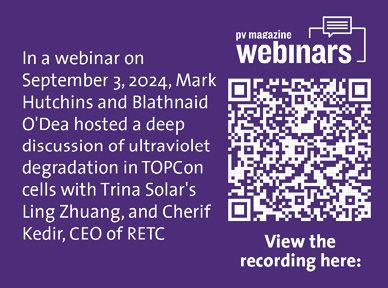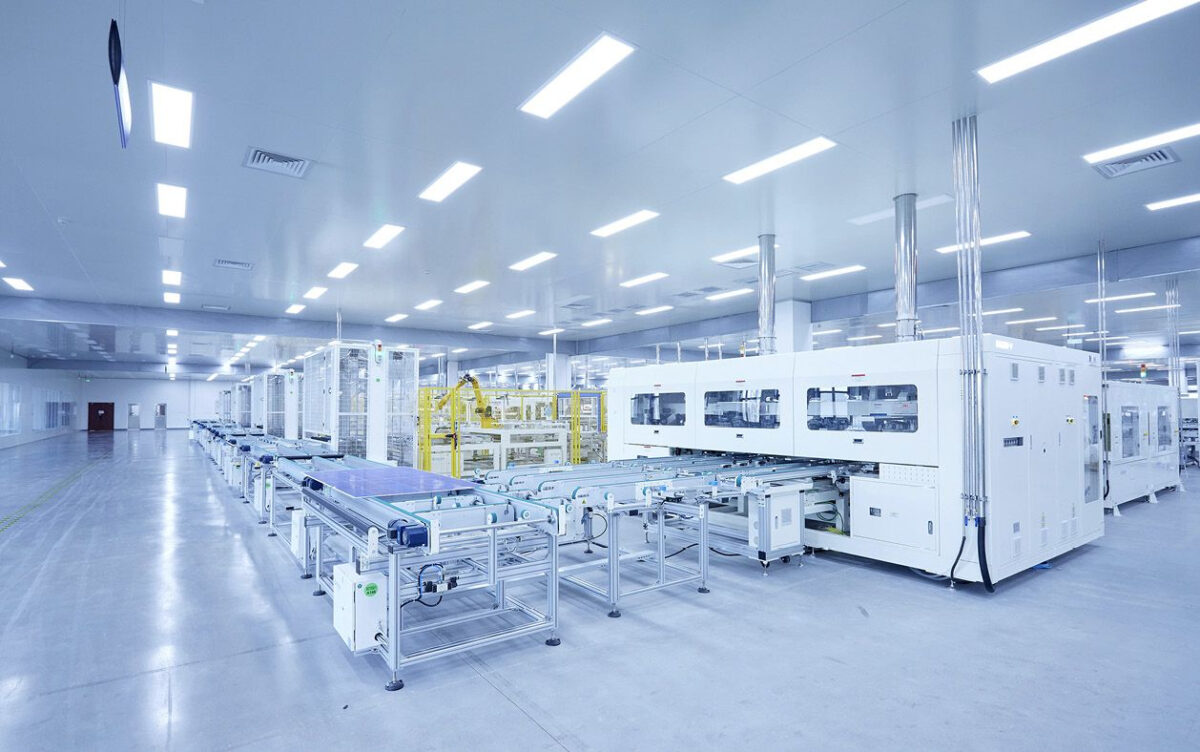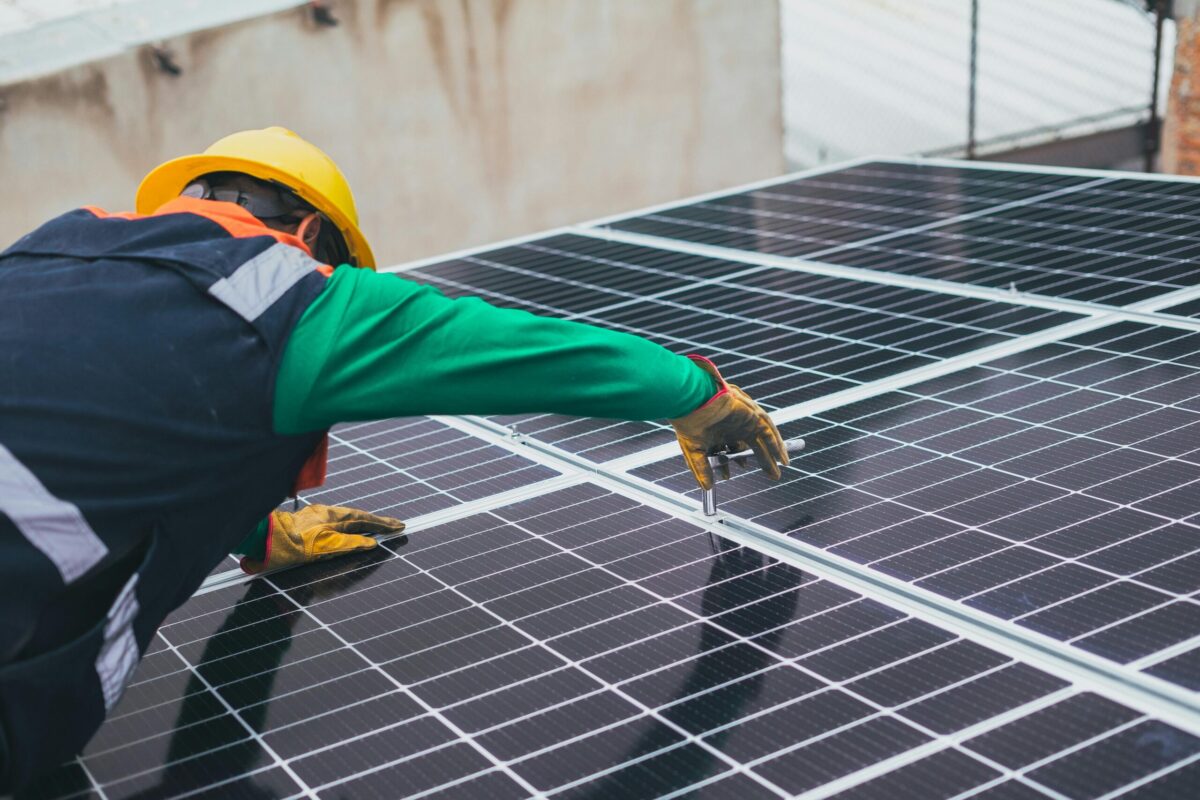From pv magazine 10/24
Results from PV testing laboratories in 2024 have raised concern over ultraviolet-induced degradation (UVID) in some n-type TOPCon and HJT panels. The “PV Module Index Report” from the Renewable Energy Test Center (RETC) noted 40% of tested modules exhibited at least 5% performance loss after UV testing.
The Kiwa PVEL lab, also in California, carried out UV testing at 120 kWh/m² exposure – designed to replicate six months to two years in the field, depending on location – and reported up to 16.6% performance loss in some n-type TOPCon modules. The lab’s vice president of sales and marketing, Tristan Erion-Lorico, said that 16.6% power loss, based on typical performance warranties guaranteeing a maximum 1% power loss after year one, and 0.4% thereafter, would be expected for a module that had been deployed for 40 years.
Testing programs also found plenty of modules that were more resilient to UVID. Of those tested by RETC, 40% saw less than 2% power loss, and about half of the modules included in Kiwa PVEL’s PV Module Reliability Scorecard saw less than 3% power loss. But these results certainly warrant a closer look at ultraviolet light-induced degradation in PV modules, the mechanisms that cause it, and how it can best be avoided.
UV testing
UV testing was long a standard, and performance loss due to browning of the encapsulant or tape used to hold cells in place was a common sight in older generations of PV modules. This problem was quickly addressed by encapsulant suppliers.
With few modules experiencing UV-related problems after that, testing focus shifted to what were more pressing issues at the time, such as light induced and potential induced degradation issues. International Electrotechnical Commission (IEC) solar module standards specify just 15 kWh/m² of UV exposure, to weed out the poorest performers.
UVID is back, however, with newer devices manufactured using thinly deposited layers of multiple materials appearing to make TOPCon and HJT modules susceptible.
“Feedback that we got from the research community suggests that for these more delicate cell structures, UV is a more significant factor,” said Erion-Lorico. “It was reintroduced into extended reliability tests, including Kiwa PVEL’s PQP.”
Devising accelerated tests to accurately predict how UV light will affect PV modules over 30 years in the field poses a significant challenge. Tests can currently accelerate by a factor of around five – meaning that one full year in a UV test chamber would represent five years installed in the field, according to Erion-Lorico’s estimates. “It’s hard to accelerate UV testing much more than we’re already doing and still have the results representative to field conditions, not just frying the module,” he explained.
Added complexity also comes from the very different levels of UV exposure modules can experience, depending on where they are installed. Data from the Middle East Solar Industry Association indicate that a module installed in Dubai receives 5.4 times the UV exposure of one installed in Berlin, for example.
 RETC Chief Executive Cherif Kedir said, in a September 2024 pv magazine webinar, that UV degradation is a cumulative effect and even where testing has shown a module is susceptible to UV damage, longer term observation is needed to indicate the progression over time.
RETC Chief Executive Cherif Kedir said, in a September 2024 pv magazine webinar, that UV degradation is a cumulative effect and even where testing has shown a module is susceptible to UV damage, longer term observation is needed to indicate the progression over time.
“We’re trying to perform long term UV exposures to see if [a PV module] keeps degrading every year,” said Kedir, adding that another unknown is whether even low-level UV degradation could then trigger other weaknesses or degradation mechanisms. “These are all issues that are not known by the industry and there’s a lot of research going on.”
Mechanisms and mitigation
Archana Sinha, now a senior engineer with Kiwa PVEL, has researched the effects of UV on solar cells for several years. “There are definitely multiple degradation mechanisms,” she told pv magazine. “Some are likely stronger than others and some may be partly reversible.”
Work by Sinha and other researchers has revealed three main degradation mechanisms driven by ultraviolet light, which are related to the intricacies of cell structure and module encapsulation. Sinha explained that susceptibility to UVID relates to the material and thickness of various layers within a solar cell. Thinner layers and certain materials such as silicon nitride, with a refractive index of less than 2.29, exhibit increased UV transparency.
This means they let in more light, and more UV. Once inside a cell, short wavelength UV photons have sufficient energy to break the chemical bond between silicon and hydrogen, damaging cell passivation and reducing a device’s efficiency. The quality of a cell itself also plays a role. “If it has more defect states present in the base layer, then it can accelerate the degradation,” said Sinha.
When it comes to reducing the effects of these mechanisms, there are three possible routes. The first two methods concern preventing UV photons from reaching the cell, either through low UV transmission module glass or using encapsulant materials tailored to block UV or “downshift” UV photons to visible light. The third option is to engineer the weakness out of the cell itself.
Chinese encapsulant supplier Cybrid Technologies has developed a UV-mitigating encapsulant for HJT modules, a light conversion film (LCF) that it introduced to the market in 2023 and calls Raybo. The film creates a layer between glass and module that can absorb UV photons and emit less damaging blue light in the visible spectrum.
Module maker Huasun uses LCF in its latest HJT modules and has noted the added cost involved – which Cybrid estimated at around $0.50/m2 higher than a standard encapsulant – is largely offset by the increased conversion efficiency afforded. “At this moment, we do not see cell-level mitigation mechanisms that have a significant impact,” said Christian Comes, director of business development Europe at Huasun. “We continue to investigate but LCF has demonstrated longevity and very good mitigation of the UV effects on the cell. It is therefore, at this moment, our main strategy to ensure reliability and durability for UV damage.”
A Cybrid representative said the company is also working on an LCF solution for TOPCon cells. The representative said this requires a slightly different encapsulant recipe since TOPCon cells are more sensitive to corrosion, and noted TOPCon customers tend to be more cost sensitive.
Cell-level solutions
TOPCon producers appear to have more opportunity to address the issue at the cell level, and that is also the approach favored by module testing experts. “I would feel a lot more comfortable with cells that don’t exhibit the susceptibility,” said RETC’s Kedir. “Fixing problems at the root cause is always better and it’s always cheaper, because a film adds cost.”
 During the same pv magazine webinar, Trinasolar Product Manager Ling Zhuang noted that the company’s Vertex TOPCon modules saw performance losses of 1.44% on the front side and 1.06% on the rear side after going through RETC’s UV testing protocol exposing the module to UV light at 220 kWh/m². In further testing authorized by China General Certification Center, the modules were exposed to UV at 300 kWh/m² and saw 1.64% frontside power degradation, and 1.26% rear side. Zhuang noted that after the UV test cycle, the module also passed insulation and wet leakage current tests.
During the same pv magazine webinar, Trinasolar Product Manager Ling Zhuang noted that the company’s Vertex TOPCon modules saw performance losses of 1.44% on the front side and 1.06% on the rear side after going through RETC’s UV testing protocol exposing the module to UV light at 220 kWh/m². In further testing authorized by China General Certification Center, the modules were exposed to UV at 300 kWh/m² and saw 1.64% frontside power degradation, and 1.26% rear side. Zhuang noted that after the UV test cycle, the module also passed insulation and wet leakage current tests.
Zhuang puts that strong performance down to careful process design, control, and monitoring during cell production. She explained that Trina’s passivation structure ensures low self-absorption, keeping UV photons away from where they could do damage. It also uses careful measurements to control the thickness of the passivation layer. Zhuang explained that while some manufacturers calculate using average film thickness per cell, Trina does the calculation based on the thickness measured at several selected points on each cell, ensuring better uniformity. She added, careful monitoring of cell processes is key to spotting potential issues in production before they affect a large number of devices. “We applied intelligent information management … to monitor the whole process and identify potential challenges,” said Zhuang.
Industry experts agree that although UVID can be controlled during the manufacturing process, not all solar manufacturers are taking such a careful approach. “We’re seeing a range of test results and it’s certainly not the case that TOPCon isn’t reliable,” said Kiwa-PVEL’s Erion-Lorico. “But manufacturers and their customers need to be aware of the risk here.”
Road to recovery
Researchers have observed that when placed under certain conditions, solar cells can recover some of the performance lost to UVID. More work on this could help create a solution for modules that have already left the factory.
“If we can develop recovery strategies that help in mitigating those problems, we will give that feedback to both upstream and downstream partners,” said Sinha.
A 2024 study by German research institute Fraunhofer ISE reported some recovery from UVID after humidity freeze testing. Kiwa PVEL has received a grant from the US Department of Energy’s DuraMAT Consortium for a two-year study into UVID, including learning more about possible recovery mechanisms.
“I think we will see some recovery mechanisms that you can use in the field but there will certainly be others where the cell has degraded and you can’t change what has been damaged,” said Erion-Lorico.
This content is protected by copyright and may not be reused. If you want to cooperate with us and would like to reuse some of our content, please contact: editors@pv-magazine.com.









By submitting this form you agree to pv magazine using your data for the purposes of publishing your comment.
Your personal data will only be disclosed or otherwise transmitted to third parties for the purposes of spam filtering or if this is necessary for technical maintenance of the website. Any other transfer to third parties will not take place unless this is justified on the basis of applicable data protection regulations or if pv magazine is legally obliged to do so.
You may revoke this consent at any time with effect for the future, in which case your personal data will be deleted immediately. Otherwise, your data will be deleted if pv magazine has processed your request or the purpose of data storage is fulfilled.
Further information on data privacy can be found in our Data Protection Policy.